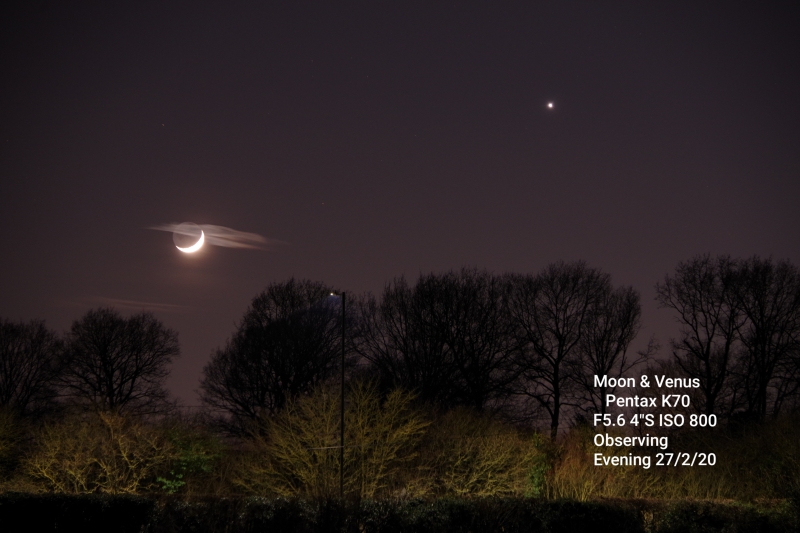Latest super image by Simon Dawes of a 22 day old Moon taken on the 23rd Feb 2022 in Bexleyheath.

Astronomy every Thursday
Latest super image by Simon Dawes of a 22 day old Moon taken on the 23rd Feb 2022 in Bexleyheath.

[caption id="" align="aligncenter" width="800"] Crescent Moon and Mars near the constellation of Auriga taken on 13/05/21 with a pentax K70 . 135mm /f8.0 iso 800 1/5 sec.[/caption]
[caption id="" align="aligncenter" width="800"] Image of the Crescent Moon and Mercury taken on the 13/05/21 Pentax K70 135mm f8.0 iso 800 1/5 sec.[/caption]
[et_pb_section fb_built="1" _builder_version="4.4.2"][et_pb_row column_structure="1_4,1_4,1_4,1_4" _builder_version="4.4.2"][et_pb_column type="1_4" _builder_version="4.4.2"][et_pb_text _builder_version="4.4.2"]
[/et_pb_text][/et_pb_column][et_pb_column type="1_4" _builder_version="4.4.2"][et_pb_text _builder_version="4.4.8"]
[/et_pb_text][/et_pb_column][et_pb_column type="1_4" _builder_version="4.4.2"][et_pb_text _builder_version="4.7.7" hover_enabled="0" sticky_enabled="0"]
[/et_pb_text][/et_pb_column][et_pb_column type="1_4" _builder_version="4.4.2"][et_pb_text _builder_version="4.7.7" hover_enabled="0" sticky_enabled="0"]
[/et_pb_text][/et_pb_column][/et_pb_row][/et_pb_section]
[et_pb_section fb_built="1" _builder_version="4.4.7" global_colors_info="{}"][et_pb_row _builder_version="4.4.7" global_colors_info="{}"][et_pb_column type="4_4" _builder_version="4.4.7" global_colors_info="{}"][et_pb_text _builder_version="4.4.7" global_colors_info="{}"]
The recent conjunction of the Moon, Venus and Mercury in the evening sky has been delighting our members, below are some contributions from those who imaged it.
[caption id="" align="aligncenter" width="800"]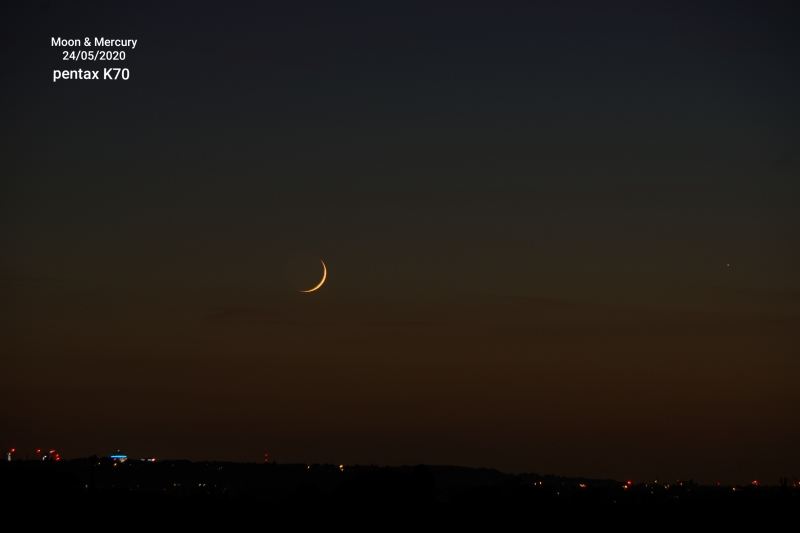 Image by Jim Burchell The Moon and Mercury showing Earthshine. Taken Dartford top road. Pentax K70.[/caption][caption id="" align="aligncenter" width="800"]
Image by Jim Burchell The Moon and Mercury showing Earthshine. Taken Dartford top road. Pentax K70.[/caption][caption id="" align="aligncenter" width="800"] Image by John Howarth Venus is at lower right on both photos, Mercury (faint, but visible) is about equidistant from Venus and the moon, practically level with the moon.[/caption][caption id="" align="aligncenter" width="800"]
Image by John Howarth Venus is at lower right on both photos, Mercury (faint, but visible) is about equidistant from Venus and the moon, practically level with the moon. Taken from the park.[/caption]
[caption id="" align="aligncenter" width="800"] Image by Stephen Goldson 'First time I've seen Mercury clearly'[/caption]
[/et_pb_text][/et_pb_column][/et_pb_row][/et_pb_section]
[et_pb_section fb_built="1" _builder_version="4.4.6"][et_pb_row _builder_version="4.4.6"][et_pb_column _builder_version="4.4.6" type="4_4"][et_pb_text _builder_version="4.4.6" hover_enabled="0"]
[caption id="" align="aligncenter" width="800"]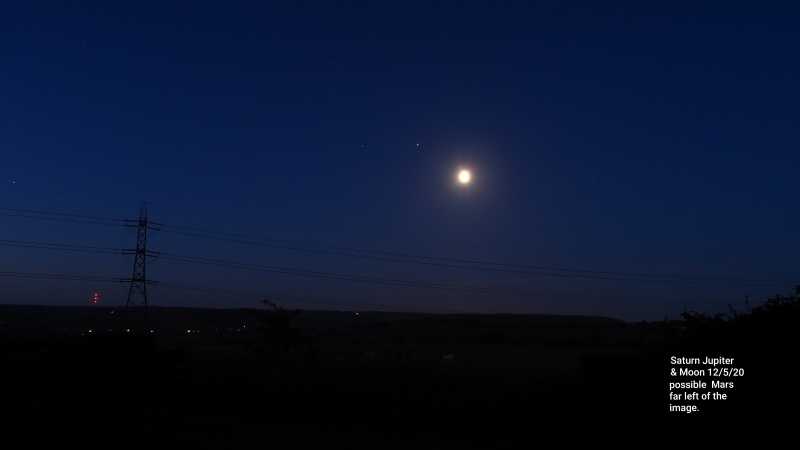 Image taken by Jim Burchell, in the early hours of 2020/05/12 capturing a conjunction of Saturn Jupiter and the moon .possible Mars far left of the image..[/caption]
Image taken by Jim Burchell, in the early hours of 2020/05/12 capturing a conjunction of Saturn Jupiter and the moon .possible Mars far left of the image..[/caption]
[/et_pb_text][/et_pb_column][/et_pb_row][/et_pb_section]
[et_pb_section fb_built="1" _builder_version="4.4.2"][et_pb_row _builder_version="4.4.2" column_structure="1_4,1_4,1_4,1_4"][et_pb_column _builder_version="4.4.2" type="1_4"][et_pb_text _builder_version="4.4.2" admin_label="image" hover_enabled="0"]
[/et_pb_text][/et_pb_column][et_pb_column _builder_version="4.4.2" type="1_4"][et_pb_text _builder_version="4.4.2" admin_label="Image" hover_enabled="0"]
[/et_pb_text][/et_pb_column][et_pb_column _builder_version="4.4.2" type="1_4"][/et_pb_column][et_pb_column _builder_version="4.4.2" type="1_4"][/et_pb_column][/et_pb_row][/et_pb_section]
[et_pb_section fb_built="1" _builder_version="4.4.2"][et_pb_row column_structure="1_4,1_4,1_4,1_4" _builder_version="4.4.2"][et_pb_column type="1_4" _builder_version="4.4.2"][et_pb_text _builder_version="4.4.2"]
[/et_pb_text][/et_pb_column][et_pb_column type="1_4" _builder_version="4.4.2"][et_pb_text _builder_version="4.4.2"]
[/et_pb_text][/et_pb_column][et_pb_column type="1_4" _builder_version="4.4.2"][et_pb_text _builder_version="4.4.9"]
[/et_pb_text][/et_pb_column][et_pb_column type="1_4" _builder_version="4.4.2"][/et_pb_column][/et_pb_row][et_pb_row _builder_version="4.7.7" _module_preset="default"][et_pb_column _builder_version="4.7.7" _module_preset="default" type="4_4"][et_pb_text _builder_version="4.7.7" _module_preset="default" hover_enabled="0" sticky_enabled="0"]
[caption id="" align="aligncenter" width="800"] Image by Richard Bohner. Photo info: taken on 13 April 2021 @ 7:52PM local time, Arizona. Canon 5D MK IV, ISO 800, 3sec. Exp. telephoto f5.6 400mm.[/caption]
[/et_pb_text][/et_pb_column][/et_pb_row][/et_pb_section]
[et_pb_section fb_built="1" _builder_version="4.4.1"][et_pb_row _builder_version="4.4.1"][et_pb_column type="4_4" _builder_version="4.4.1"][et_pb_text _builder_version="4.4.1" hover_enabled="0"]
We have had some lovely clear and moonless nights the last couple of days and on top of this few contrails from planes making the sky ideal for observing, and whilst alone with your telescope or binoculars you can still share your experiences using our WhatsApp groups, just contact committee@crayfordmanorastro.com if you want to be added...
Here is a selection of member observations shared over the last few nights.
[caption id="" align="aligncenter" width="800"] Image by John Archer - 20s no other details provided[/caption][caption id="" align="aligncenter" width="640"]
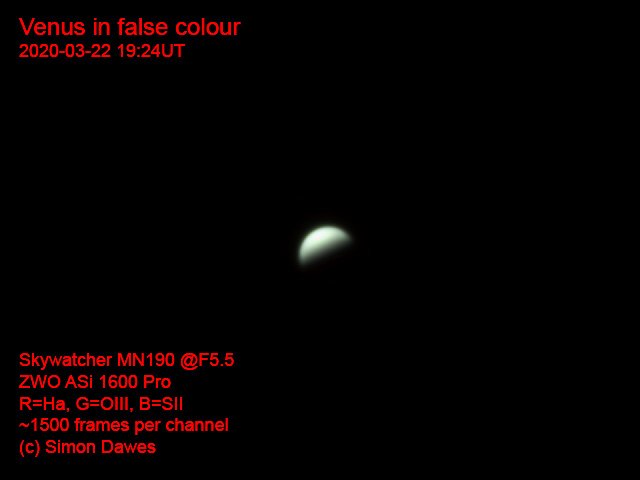 Image by Simon Dawes It's been 11 years, 1 month and 5 days since I last imaged Venus, now I remember why...[/caption][caption id="" align="aligncenter" width="615"]
Image by Simon Dawes It's been 11 years, 1 month and 5 days since I last imaged Venus, now I remember why...[/caption][caption id="" align="aligncenter" width="615"]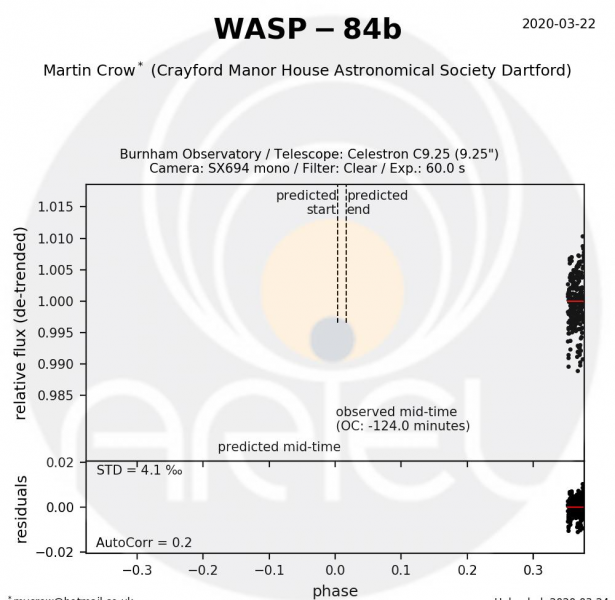 Data measured by Martin Crow So my non transit resulted in showing up an error in NASA’s exoplanet archive. The mistake has now been corrected apparently. This is a good result as finding errors once Ariel is up would not be great[/caption][caption id="" align="aligncenter" width="800"]
Data measured by Martin Crow So my non transit resulted in showing up an error in NASA’s exoplanet archive. The mistake has now been corrected apparently. This is a good result as finding errors once Ariel is up would not be great[/caption][caption id="" align="aligncenter" width="800"]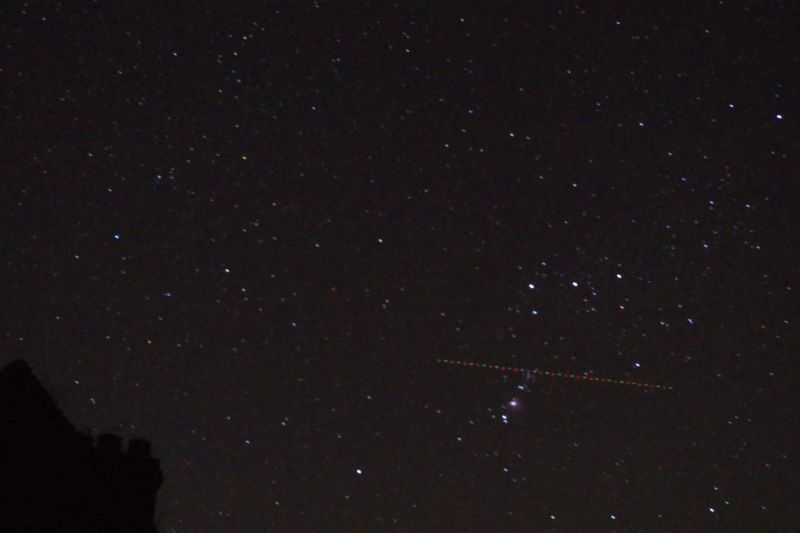 Image by John Archer of the ISS - no details provided[/caption][caption id="" align="aligncenter" width="765"]
Image by John Archer of the ISS - no details provided[/caption][caption id="" align="aligncenter" width="765"]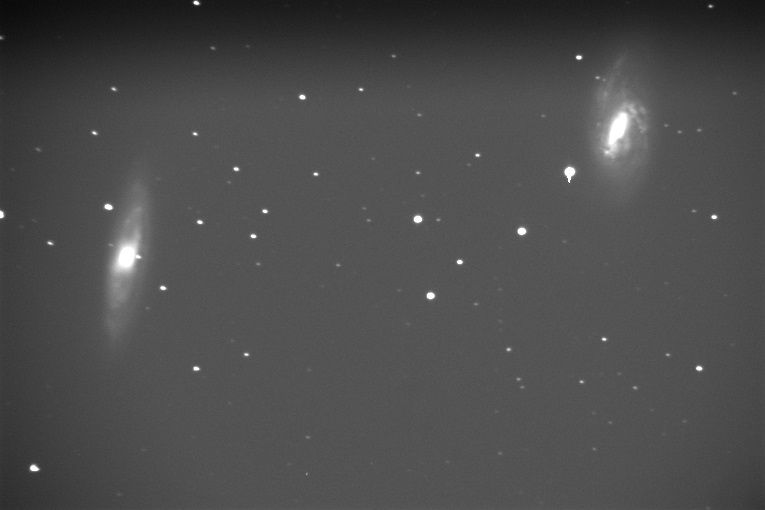 Here is a test CCD image of the galaxies M65 (left) and M66, part of the Leo Triplet, which I took last night. My guiding still needs sorting out...[/caption]
Here is a test CCD image of the galaxies M65 (left) and M66, part of the Leo Triplet, which I took last night. My guiding still needs sorting out...[/caption]
[/et_pb_text][/et_pb_column][/et_pb_row][et_pb_row column_structure="1_2,1_2" _builder_version="4.4.1"][et_pb_column type="1_2" _builder_version="4.4.1"][et_pb_text _builder_version="4.4.1"]
[caption id="" align="aligncenter" width="600"] Image by Kurt Appreciate this will be basic stuff to most of you, but here's my first astrophotography effort of the full moon a few weeks back. Nothing too complex, 5inch SCT and snapped with a Pixel 4 phone.[/caption]
Image by Kurt Appreciate this will be basic stuff to most of you, but here's my first astrophotography effort of the full moon a few weeks back. Nothing too complex, 5inch SCT and snapped with a Pixel 4 phone.[/caption]
[/et_pb_text][/et_pb_column][et_pb_column type="1_2" _builder_version="4.4.1"][et_pb_text _builder_version="4.4.1"]
[caption id="" align="aligncenter" width="600"]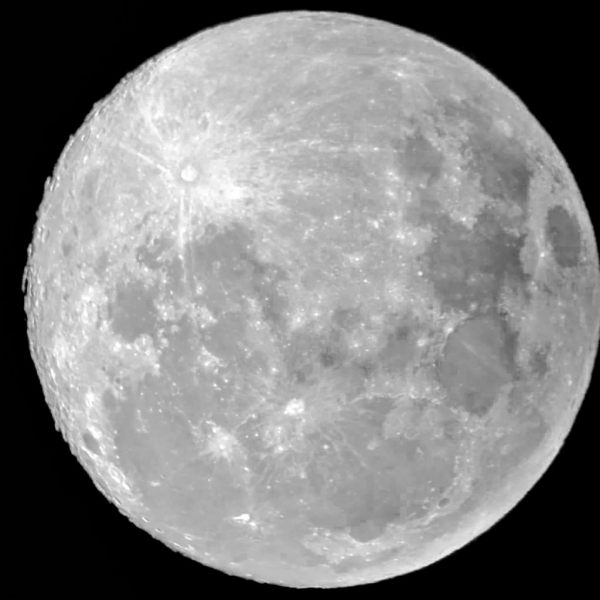 Edited by Martin Just adjusted highlights and shadows mostly. You may already know this but it’s always worth looking from the edge of Mare Crisium to the limb of the moon. Due to libration you will see that this changes and sometimes we can see a little further around the moon.[/caption]
Edited by Martin Just adjusted highlights and shadows mostly. You may already know this but it’s always worth looking from the edge of Mare Crisium to the limb of the moon. Due to libration you will see that this changes and sometimes we can see a little further around the moon.[/caption]
[/et_pb_text][/et_pb_column][/et_pb_row][/et_pb_section]
Image taken by Jim Burchell during an observing evening at Sutton-at-Hone.
